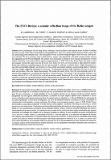Por favor, use este identificador para citar o enlazar a este item:
http://hdl.handle.net/10261/238210COMPARTIR / EXPORTAR:
 SHARE
BASE SHARE
BASE
|
|
| Visualizar otros formatos: MARC | Dublin Core | RDF | ORE | MODS | METS | DIDL | DATACITE | |

| Título: | The ESCl-Béticas: a seismic reflection image of the Betics orogen |
Autor: | Carbonell, Ramón CSIC ORCID ; Torné, Montserrat CSIC ORCID ; García Dueñas, V.; Moya, R.; Banda, E. | Palabras clave: | Betic Cordillera Seismic reflexion Tectonic model Geodynamics |
Fecha de publicación: | 1995 | Editor: | Sociedad Geológica de España | Citación: | Revista de la Sociedad Geológica de España 8: 503- 512 (1995) | Resumen: | El reprocesado de las perfiles de sísmica de reflexión profunda adquiridos a través de la cordillera Bética, proporcionan una imagen de los elementos tectónicos que muy probablemente han estado activos durante el desarrollo del orógeno.
El nuevo procesado y el estudio detallado de los los registros sísmicos de los disparos, revela una corteza superior transparente con sólo algunos reflectores importantes. El reflector de mayor amplitud aparece como subparalelo a una estructura milonítica relativamente gruesa que hace de contacto entre el Alpujáride y el Nevado Filábride. La atenuación de las ondas superficiales a través de la prolongación a un nivel de referencia mediante la ecuación de ondas ha permitido la visualización de reflectividad a niveles superficiales. Un reflector muy prominente aparece a unos 6 s DTR (Doble Tiempo de Recorrido) y que podria corresponder al límite entre la corteza superior y la inferior. Por debajo de este nivel, la corteza presenta una alta reflectividad. Simulaciones mediante diferencias finitas del campo de ondas sugieren que el reflector localizado a 6 s es, probablemente, la respuesta de una estructura laminar. Entre la estructura altamente reflectante que marca el limite superior de la corteza inferior y la transición corteza-manto se han visualizado unas bandas entrelazadas que sugieren estructuras en boudinage. Los registros de los disparos presentan un reflector de gran amplitud que puede correlacionarse con la base de la corteza (Moho), La naturaleza multicíclica, la elevada amplitud, y los máximos del espectro de frecuencias, sugieren que corresponde a la respuesta sísmica de una estructura laminar. La distribución de velocidades determinada New processing of the two deep seismic reflection normal incidence data acquired across the Betic Cordillera provides an image of the main tectonic features, that probably ha ve been active during the development of the oro gen. The new processing and the detailed study of the shot gathers reveals an almost transparent upper crust, with only a few prominent reflectors. The most prominent upper crustal reflector, appears to be subparallel to the thick mylontic contact between the Alpujárride and the Nevado-Filábride. The surface wave attenuation by means of wave equation datuming has revealed shallow reflectivity. A prominent reflector appears at approximately 6 s TWTT (Two Way Travel Time) that seems to mark the boundary between the upper crust and the lower crust. Below this level, the crust presents a high reflectivity pattem. Elastic finite difference modelling supports that the high amplitude 6 s reflector is probably due to a highly laminated structure. Between the highly reflective top of the lower crust and the crust mantle transition, anastomousing bands of reflectors have been imaged, suggesting boudinage like structures. The shot gathers present a high amplitude event that can be correlated with the base of the crust (Moho discontinuity). The multicyclic nature of the event, the high amplitude, and the frequency peaks, suggest that it is probably the response of a layered structure. The analysis of the shot gathers indicated a low average velocity of 6.3 ± 0.2 km/s for the crust and an average crustal thickness of 35 ± 2 km where the crust-to-mantle transition is marked by a prominent reflected event. These results are consistent with older seismic refraction data. These results constitute the key features for the development of a tectonic model characterised by structures which can physically accommodate the complicated tectonics that have affected the area |
URI: | http://hdl.handle.net/10261/238210 | Identificadores: | issn: 0214-2708 |
| Aparece en las colecciones: | (Geo3Bcn) Artículos |
Ficheros en este ítem:
| Fichero | Descripción | Tamaño | Formato | |
|---|---|---|---|---|
| 1995_Carbonell_etal_ESCI-Beticas_RSGE.pdf | 1,37 MB | Adobe PDF |  Visualizar/Abrir |
CORE Recommender
Este item está licenciado bajo una Licencia Creative Commons

